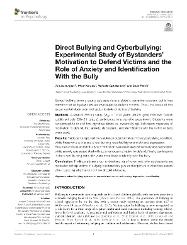| dc.contributor.author | Jungert, Tomas | |
| dc.contributor.author | Karataş, Pınar | |
| dc.contributor.author | Iotti, Nathalie Ophelia | |
| dc.contributor.author | Perrin, Sean | |
| dc.date.accessioned | 2021-04-23T14:36:04Z | |
| dc.date.available | 2021-04-23T14:36:04Z | |
| dc.date.issued | 2021-01 | |
| dc.identifier.issn | 1664-1078 | en_US |
| dc.identifier.uri | https://hdl.handle.net/20.500.12469/3992 | |
| dc.description.abstract | School bullying among young adolescents is a globally pervasive problem, but is less common when bystanders are motivated to defend victims. Thus, the focus of this experimental study is on motivation to defend victims of bullying.
Methods: A total of 388 students (M (age) = 12.22 years, 49.7% girls) from two Turkish public schools (5th-8th grade) participated in a vignette experiment. Students were randomized to one of two vignettes (direct vs. cyberbullying). Self-report measures of motivation to defend, trait anxiety, depression, and identification with the victim or bully were used.
Results: Participants reported more autonomous motivation in the cyberbullying condition, while those who witnessed direct bullying reported higher anxiety and depression.
Results also revealed that this type of condition was associated with anxiety and depression, while anxiety was associated with autonomous motivation to defend. Finally, participants in the direct bullying condition were more likely to identify with the bully.
Conclusion: Findings advance our understanding of when and why adolescents are motivated to help victims of bullying because they give a richer picture of what they assess when deciding whether or not they should intervene. | en_US |
| dc.language.iso | eng | en_US |
| dc.publisher | FRONTIERS MEDIA SA | en_US |
| dc.rights | info:eu-repo/semantics/openAccess | en_US |
| dc.subject | school bullying | en_US |
| dc.subject | bystanders | en_US |
| dc.subject | prosocial motivation | en_US |
| dc.subject | trait anxiety | en_US |
| dc.subject | depression | en_US |
| dc.subject | identification | en_US |
| dc.title | Direct Bullying and Cyberbullying: Experimental Study of Bystanders' Motivation to Defend Victims and the Role of Anxiety and Identification With the Bully | en_US |
| dc.type | article | en_US |
| dc.relation.journal | FRONTIERS IN PSYCHOLOGY | en_US |
| dc.identifier.volume | 11 | en_US |
| dc.identifier.wos | WOS:000614267500001 | en_US |
| dc.identifier.doi | 10.3389/fpsyg.2020.616572 | en_US |
| dc.identifier.scopus | 2-s2.0-85100535251 | en_US |
| dc.institutionauthor | Karataş, Pınar | en_US |
| dc.relation.publicationcategory | Makale - Uluslararası Hakemli Dergi - Kurum Öğretim Elemanı | en_US |
| dc.identifier.pmid | 33551927 | en_US |
















